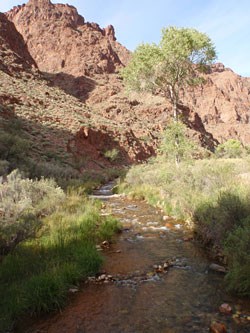
The National Park Service is conducting a multi-year project to reduce the number of non-native brown and rainbow trout in Bright Angel Creek in order to benefit native fish populations in Grand Canyon National Park. Grand Canyon's native fish are uniquely adapted to the characteristics of the Colorado River and its tributaries and have suffered serious declines due to human-caused changes to their habitat. Bright Angel Creek once supported large numbers of native fish, including the endangered humpback chub. Today, Bright Angel Creek is the main spawning site in Grand Canyon for non-native brown trout, which are voracious predators of native fish. Biologists are using two methods for capturing and removing non-native trout in the lower reach of Bright Angel Creek during the winter months: a weir, or fish trap, and electro-fishing. The weir captures large trout that live in the Colorado River as they enter Bright Angel Creek to spawn. Electro-fishing allows fisheries biologists to monitor and assess the fish population of the creek and also remove non-native trout that live in the stream. This project is funded by the Bureau of Reclamation and National Park Service, with staff contributions by the University of Missouri and volunteers provided by the Grand Canyon Trust. Native versus Non-native Fish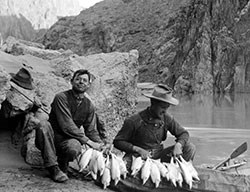
Robust populations of native fish are important indicators of an aquatic ecosystem's overall health. National Park Service Management Policies require that species and natural ecosystems are preserved, and that recovery actions are taken when park resources have been damaged or compromised. A variety of laws, including the Endangered Species Act, require the protection of rare or endemic species. The Bright Angel Creek Trout Reduction Project is part of a larger effort to restore habitats and native fish throughout the park. Trout species are not native to the Colorado River and its tributaries in Grand Canyon. Brown and rainbow trout were stocked in Grand Canyon in the first half of the last century before the existence of current environmental regulations and development of ecological knowledge of aquatic systems. Today, brown trout, a species native to Europe and Asia, is the most common fish species found in Bright Angel Creek. As recently as the 1970s, brown trout were rare in Bright Angel Creek. Along with the increase in the number of brown trout in Bright Angel Creek since the 1990s, there has been a corresponding decline in native fish. Bright Angel Creek is now an important spawning site for brown trout, and a large number are found in the Colorado River near the confluence with Bright Angel Creek. Much of the diet of brown trout in Grand Canyon consists of fish, and they preferentially consume native fish. Hence, the presence of brown trout likely has significant impact on the native fish population in the Colorado River and Bright Angel Creek. Trout that spawn in Bright Angel Creek have been captured in other parts of the Colorado River. For example, large rainbow and brown trout caught last year in Bright Angel Creek were originally tagged with passive-integrated transponder tags (PIT tags), or microchips, in the Little Colorado River confluence, more than 26 miles away. The Little Colorado River confluence contains the largest remaining population of humpback chub left in the world, and is an important area for other native fish species. Non-native Trout Removal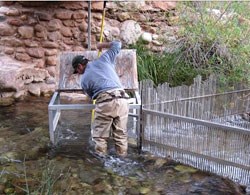
The purpose of the Bright Angel Creek Trout Reduction Project is to benefit endangered humpback chub and other native fish species in the Colorado River, and to restore and enhance, to the extent possible, the native fish community that once flourished in Bright Angel Creek. Grand Canyon fisheries biologists are using two approaches to achieve these objectives: a fish weir and backpack electro-fishing. 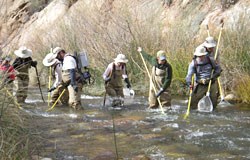
Initial Results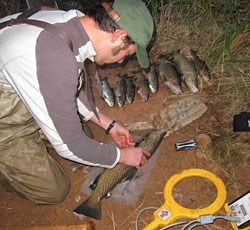
Electro-fishing techniques enable biologists to both monitor native and non-native fish populations, and also remove non-native fish from the stream. In 2010-2011, biologists removed 594 brown trout and 454 rainbow trout in lower Bright Angel Creek by electro-fishing, estimated to be between 55 and 89% of the trout that were present. A multi-faceted approach to restoration in Bright Angel Creek is important because electrofishing targets non-native trout that are residents in the creek and the weir captures trout that are moving into and out of the creek from the Colorado River. These techniques capture different size classes of the non-natives. The weir has captured larger brown and rainbow trout, up to 25 inches (634 mm) in length, much longer than those captured using electro-fishing equipment. These larger fish carry proportionally more eggs (as much as 20% of their weight) and, because of their size, are more likely to consume native fish. Electro-fishing also allows biologists to collect a wider size range of trout from Bright Angel Creek, and allows for biologists to estimate the population size for both the native and non-native fish species. In order to determine whether the project is successful in reducing trout numbers in the Colorado River, the project and associated monitoring will need to continue for several years. Based on modeling of brown trout population dynamics, additional control measures may be necessary to maintain low numbers of these non-native predators in Bright Angel Creek and the Colorado River. Park managers consider the project an important outreach opportunity to discuss the ecological significance of Grand Canyon's native fish with park visitors. In 2010-2011, NPS fisheries biologists discussed the project on site with 120 different visitor groups ranging in size from 1-15 people. Most visitors contacted about the project were supportive of the park's efforts to restore native fish populations in Bright Angel Creek. Bright Angel Creek AnglingAnglers visiting Phantom Ranch can expect to encounter fewer trout in Bright Angel Creek between the Bright Angel Campground and Phantom Creek.However, opportunities to catch large rainbow and brown trout continue to exist in the Colorado River near the confluence with Bright Angel Creek. No bag limit for brown or rainbow trout is in effect for Bright Angel Creek. Anglers are encouraged to keep and enjoy the trout they catch. |
Last updated: February 24, 2015
